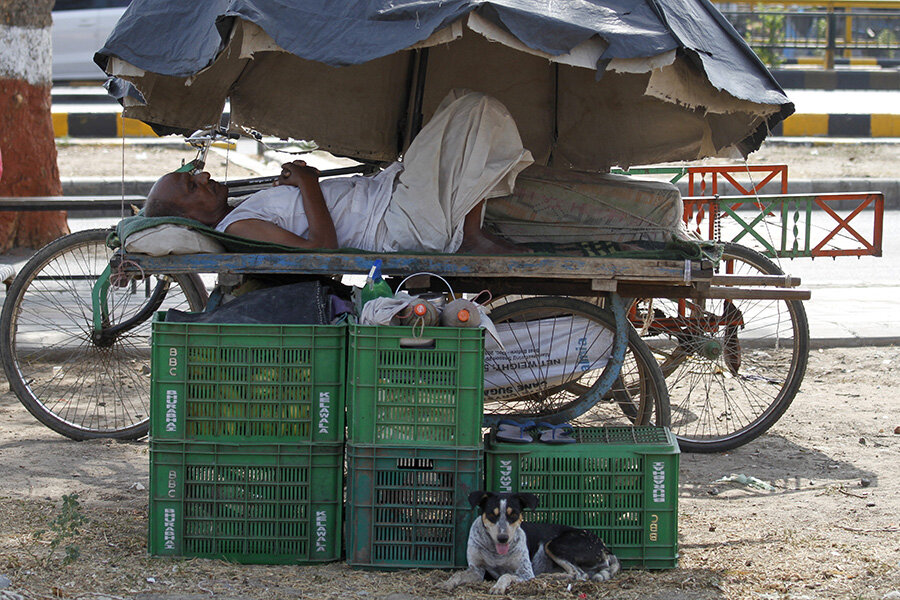Those who must work in deadly India heat wave
| Hyderabad, India
Eating onions, lying in the shade and splashing into rivers, Indians were doing whatever they could Thursday to stay cool during a brutal heat wave that has killed more than 1,400 in the past month.
But some had no choice but to venture into the heat.
"Either we have to work, putting our lives under threat, or we go without food," farmer Narasimha said in the badly hit Nalgonda district of southern Andhra Pradesh state.
Meteorological officials have said the heat would likely last several more days — scorching crops, killing wildlife and endangering anyone laboring outdoors. Officials warned people to stay out of the sun, cover their heads and drink plenty of water. Still, poverty forced many to work despite the risks.
"If I don't work due to the heat, how will my family survive?" said construction worker Mahalakshmi, who earns a daily wage of about $3.10 in Nizamabad, a city about 150 kilometers (93 miles) north of the state capital of Hyderabad.
Most of the 1,412 heat-related deaths so far have occurred in Andhra Pradesh and neighboring Telangana, where temperatures have soared to 47 degrees Celsius (117 degrees Fahrenheit), according to government figures.
"The rains which have eluded us for the last couple of years have created serious drought conditions," said state minister K.T. Rama Rao in Telangana, which was carved out of Andhra Pradesh as a separate state just last year.
"This is unprecedented ... so there is a little bit of panic," he said. "Hopefully the monsoon will be on time. Hopefully we will receive rain very, very soon."
Among the most vulnerable were the elderly and the poor, many of whom live in slums or farm huts with no access to air conditioners or sometimes even shade-giving trees.
Those who were able avoided the outdoors, leaving many streets in normally busy cities nearly deserted.
"With so many people dying due to the heat, we are locking the children inside," teacher Satyamurthy said in Khammam, which registered its highest temperature in 67 years on Saturday when the thermometer hit 48 degrees Celsius (more than 118 Fahrenheit).
Cooling monsoon rains were expected to arrive next week in the southern state of Kerala and gradually advance north in coming weeks.
Until then, volunteers were passing out pouches of salted buttermilk or raw onions — both thought to be hydrating. People used handkerchiefs and scarves to block searing winds and stifling air from their faces.
Across the country, teenagers flocked to water basins and rivers to cool off. Many adults took refuge atop woven cots in the shade.
Newspapers devoted full pages to covering the heat wave and its effects, with headlines saying "Homeless bake in tin shelters" and "birds & animals drop dead."
In cities like New Delhi, crowds of office workers gathered around stalls selling fruit drinks and iced water, while police officers wearing sweat-soaked shirts squinted into the sun while directing road traffic.
At the zoo, leopards and tigers lay panting in the shade until zoo keepers came by every two hours with hoses. One white tiger rolled around in obvious delight while being sprayed with water. Elephants drank thirstily and lolled in a pond.
"We are even spraying the reptiles," Delhi Zoo curator Riyaz Khan said, noting fans were also set up to keep enclosures cooler, while the animals were also receiving glucose in their drinking water.
In the northern Indian states of Punjab and Haryana, Sikhs distributed free glasses of rose-scented milk to the public. Brief spurts of rain brought temporary relief to pockets of the nation, including the southern city of Chennai and the eastern city of Jharkhand.
Forecasting service AccuWeather described this as the most intense heat wave in India in recent years. The death toll for Andhra Pradesh alone, at 1,360, was higher than during a 2003 heat wave when 1,300 died in what was then a unified state including both Telangana and Andhra Pradesh.
Doctors were on alert for heat-related illness like sun stroke, and were telling people venturing outdoors to cover their heads and wear light, loose clothing, said health officer Sarojini in the city of Vishakapatnam who goes by one name, as is common in the region.
Telangana's school board postponed the start date for colleges for a week from Monday. The state also opened centers where cold water was being served, and changed the working hours for rural employment schemes, disaster management official Sada Bhargavi said.
Hyderabad resident Rajaiah, who goes by one name, was doing his newspaper delivery route at dawn to avoid peak temperatures.
"It is difficult to do this work in this harsh weather, but I have a family to take care of."





